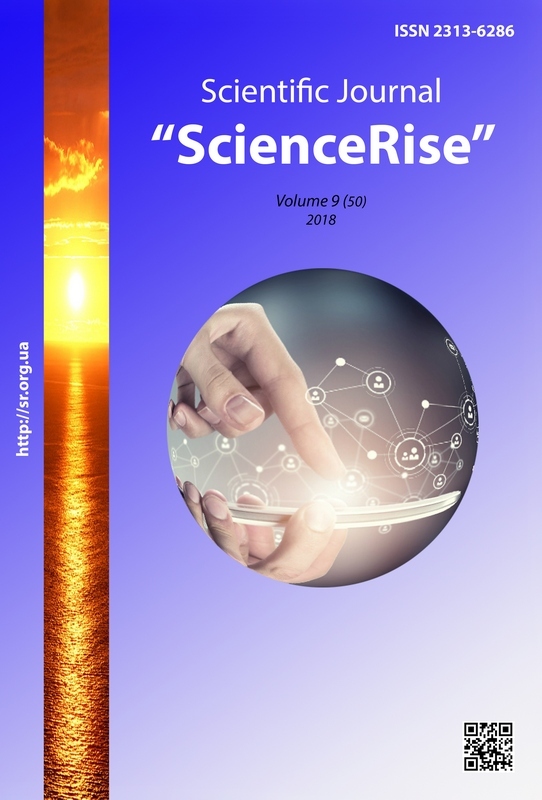Investigation of the solvent sublation patterns of cationic dyes
DOI:
https://doi.org/10.15587/2313-8416.2018.151923Keywords:
dyes, solvent sublation, sodium dodecyl sulfate, malachite green, methyl violet, crystalline violetAbstract
The basic regularities of removal of cationic dyes are established. The optimal collectors and absorbents are selected. The effect on the sublation process of the following parameters is studied: the type of absorbent, sublation duration, dyer:surfactant molar ratio, pH value of the aqueous phase, initial concentration of solutions of dyes. The highest degree of removal methyl violet, malachite green and crystalline violet is achieved with sodium dodecyl sulfate 97,43 %, 95,78 % and 98,94 % respectively, the optimal pH value is 5-7, dyer:surfactant ratio is 1:1, the duration of the process is 20 minutes, the volume of the organic layer is 10 cm3
References
Forgacs, E., Cserháti, T., Oros, G. (2004). Removal of synthetic dyes from wastewaters: a review. Environment International, 30 (7), 953–971. doi: http://doi.org/10.1016/j.envint.2004.02.001
Korsak, K. V., Plakhotnik, O. V. (2004). Osnovy suchasnoi ekolohii. Kyiv: MAUP, 340.
Singh, L., Singh, V. (2010). Biodegradation of Textile Dyes, Bromophenol Blue and Congored by Fungus Aspergillus Flavus. Environment & We: An international Journal of Science & Technology, 5, 235–242.
Mel'nikov, B. N., Shheglova, T. L., Vinogradova, G. I. (2010). Primenenie krasiteley. Moscow: BINOM. Laboratoriya znaniy, 331.
Nesterova, L. A., Sarybekov, G. S. (2010). Efficiency of use of turnaround systems of water consumption at the textile enterprises. Eastern-European Journal of Enterprise Technologies, 4 (8 (46)), 25–28. Available at: http://journals.uran.ua/eejet/article/view/3022
Kalinkin, I. P. (2002). Novyy spravochnik khimika i tekhnologa. Analiticheskaya khimiya. P. I. Saint Petersburg: ANO NPO «Mir i Sem'ya», 964.
Zapolskyi, A. K., Saliuk, A. I.; Sytnyk, K. M. (Ed.) (2001). Osnovy ekolohii. Kyiv: Vyshcha shkola, 358.
Dafnopatidou, E. K., Lazaridis, N. K. (2008). Dyes Removal from Simulated and Industrial Textile Effluents by Dissolved-Air and Dispersed-Air Flotation Techniques. Industrial & Engineering Chemistry Research, 47 (15), 5594–5601. doi: http://doi.org/10.1021/ie071235n
Astrelin, I. M., Obushenko, T. I., Tolstopalova, N. M., Targonska, O. O. (2013). Teoretychni zasady ta praktychne zastosuvannia flotoekstraktsyy: ohliad. Voda i vodoochysni tekhnolohii, 3, 3–23.
Obushenko, T., Tolstopalova, N., Kulesha, O., Astrelin, I. (2016). Thermodynamic Studies of Bromphenol Blue Removal from Water Using Solvent Sublation. Chemistry & Chemical Technology, 10 (4), 515–518. doi: http://doi.org/10.23939/chcht10.04.515
Downloads
Published
Issue
Section
License
Copyright (c) 2019 Tetjana Obushenko, Nataliia Tolstopalova, Igor Astrelin, Olena Naumenko

This work is licensed under a Creative Commons Attribution 4.0 International License.
Our journal abides by the Creative Commons CC BY copyright rights and permissions for open access journals.
Authors, who are published in this journal, agree to the following conditions:
1. The authors reserve the right to authorship of the work and pass the first publication right of this work to the journal under the terms of a Creative Commons CC BY, which allows others to freely distribute the published research with the obligatory reference to the authors of the original work and the first publication of the work in this journal.
2. The authors have the right to conclude separate supplement agreements that relate to non-exclusive work distribution in the form in which it has been published by the journal (for example, to upload the work to the online storage of the journal or publish it as part of a monograph), provided that the reference to the first publication of the work in this journal is included.

